It might be time to increase your body awareness to help you reduce your pain!

Sitting all day at work may be the culprit of your daily neck and backaches.
With most jobs now requiring long hours working at a desk, as a society, our sitting time has significantly increased over the years. The Australian Department of Health found that individuals working in more sedentary occupations, on average spent 22 hours a week sitting for work.
Current work roles require us to sit for most of our day. We sit commuting to work or university, for long hours at our desks, in meetings or eating our lunch. Once get home to relax we usually continue sitting; whether it is eating dinner, watching television, browsing our phones and laptops or reading a book.
While sitting might seem the comfortable and relaxing alternative, research suggests that prolonged postures such as sitting are in fact detrimental to our health.
One study has shown that if you sit for 7+ hours a day, you are twice as likely to develop Type 2 Diabetes and Cardiovascular disease and 13% more likely to develop cancer.
Our bodies aren’t designed to cope in a sustained sitting posture for 7+ hours a day and consequently our health is suffering from sitting!
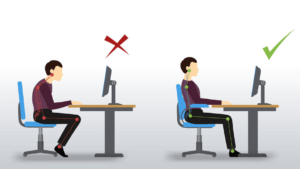
This leads us to emphasise the importance of considering the impact that your workplace ergonomics may be having on your long-term health and the pain you are enduring each working week.
We want to give you 5 simple tips to implement into your daily life to help combat the affects of prolonged sitting.
1. Become aware of your sitting posture –
Even though we are aiming to sit less, when we are sitting, we want to sit correctly. Poor posture can be characterised by a slumped position with our shoulder and heads forward and chins poking out. An easy way to correct poor posture is by drawing our shoulder blades back and performing a small chin tuck.
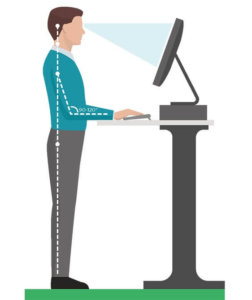
– The use of a lumbar support pillow is also a helpful way to maintain a neutral spinal posture for seated work or travel.
2. Start using a standing desk – Standing desks are becoming much more common in the workplace to reduce being sedentary in the workplace. Why not break the cycle of sitting by making a phone call or writing an email while standing instead.

3. Start walking – Australian public health targets recommend that we perform 10,000 steps per day.
Some people find the use of a pedometer or Fitbit a helpful way to track their daily steps.

4. Take regular breaks – The Australian Heart foundation recommends taking a break from sitting every
30minutes. If you notice you are sitting for prolonged periods, it may be time to cut a lap of the office or go get a drink, anything to get the feet moving and change up your posture.
5. Perform stretches – If you’ve been noticing stiffness in your neck, mid back or an aching lower back at the end of the day, stretching might be helpful to reduce your muscle related discomfort in the workplace.
Archer stretch
– Start by lying on your side, with your knees bent up and hands straight in front of you (place a pillow under your head if more comfortable).
– Reach your top arm as far as you can comfortably go. This should rotate your mid back and give a nice stretch. Bring your arm back, opening up your chest and repeat.
– Hold the position for 5 seconds. Repeat 10 times and then switch sides.
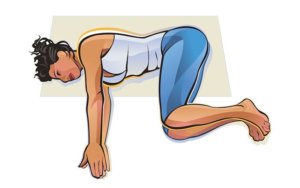
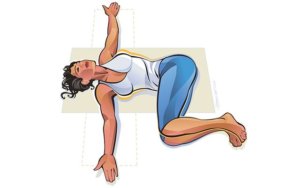
Shell stretch
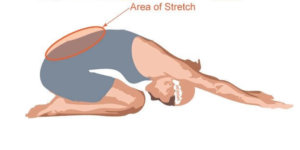 – Start by kneeling on the floor on your hands and knees
– Start by kneeling on the floor on your hands and knees
– Slowly lower your bottom, sitting back onto your heels stretching out your arms
– You should feel a nice stretch through your mid back
– Hold the position for 5 seconds. Repeat 10 times.
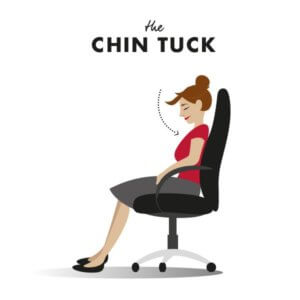
Chin tucks – Start in a sitting position with relaxed arms and shoulders
– Bring your chin down towards your chest, imagining you are lengthening the back of your neck
– Hold the position for 3 seconds. Repeat 10 times.
References
Biswas, A., Oh, P. I., Faulkner, G. E., Bajaj, R. R., Silver, M. A., Mitchell, M. S., & Alter, D. A. (2015). Sedentary time and its association with risk for disease incidence, mortality, and hospitalization in adults: a systematic review and meta-analysis. Annals of internal medicine, 162(2), 123-132. doi: 10.7326/M14-1651
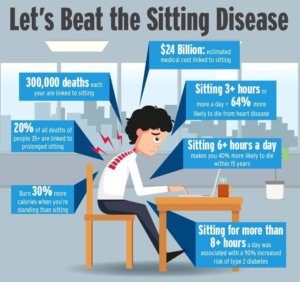 Buckley, J. P., Hedge, A., Yates, T., Copeland, R. J., Loosemore, M., Hamer, M., … & Dunstan, D. W. (2015). The sedentary office: a growing case for change towards better health and productivity. Expert statement commissioned by Public Health England and the Active Working Community Interest Company. Br J Sports Med, bjsports-2015. doi: http://dx.doi.org/10.1136/bjsports-2015-094618
Buckley, J. P., Hedge, A., Yates, T., Copeland, R. J., Loosemore, M., Hamer, M., … & Dunstan, D. W. (2015). The sedentary office: a growing case for change towards better health and productivity. Expert statement commissioned by Public Health England and the Active Working Community Interest Company. Br J Sports Med, bjsports-2015. doi: http://dx.doi.org/10.1136/bjsports-2015-094618
Ewald, B., Attia, J., & McElduff, P. (2014). How Many Steps Are Enough? Dose–Response Curves for Pedometer Steps and Multiple Health Markers in a Community-Based Sample of Older Australians. Journal of Physical Activity and Health, 11(3), 509-518. doi: https://doi.org/10.1123/jpah.2012-0091
Grondin, D. E., Triano, J. J., Tran, S., & Soave, D. (2013). The effect of a lumbar support pillow on lumbar posture and comfort during a prolonged seated task. Chiropractic & manual therapies, 21(1), 21. doi: https://doi.org/10.1186/2045-709X-21-21
Heart Foundation. (2011). Sitting less for adults. Retrieved from https://www.heartfoundation.org.au/images/uploads/publications/PA-Sitting-Less-Adults.pdf
MacEwen, B. T., MacDonald, D. J., & Burr, J. F. (2015). A systematic review of standing and treadmill desks in the workplace. Preventive medicine, 70, 50-58. doi: https://doi.org/10.1016/j.ypmed.2014.11.011
The Department of Health. (2013). Research and Statistics. Retrieved from http://www.health.gov.au/internet/main/publishing.nsf/content/health-pubhlth-strateg-active-evidence.htm
Wilmot, E. G., Edwardson, C. L., Achana, F. A., Davies, M. J., Gorely, T., Gray, L. J., … & Biddle, S. J. (2012). Sedentary time in adults and the association with diabetes, cardiovascular disease and death: systematic review and meta-analysis. doi: 10.1007/s00125-012-2677-z

